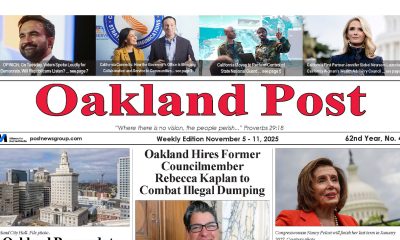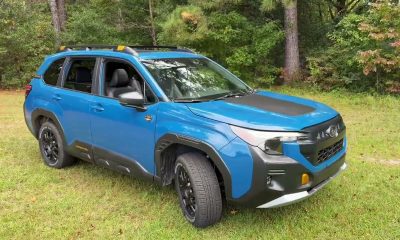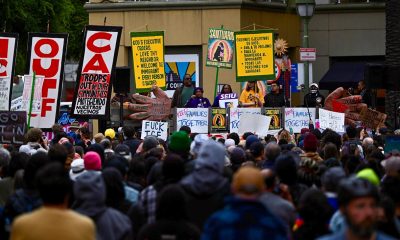Community
SAN FRANCISCO’S MOBILE VACCINATION UNIT TO VACCINATE UP TO 1,000 SENIORS IN CHINATOWN SENIOR LIVING FACILITIES
The City’s mobile vaccination units ensure equitable access to the COVID-19 vaccine for
vulnerable populations. Next week, the City will deploy a mobile vaccination team to
Chinatown’s largest senior living facility, Ping Yuen, in an effort to boost vaccination rates for
San Franciscans 65 and older.

San Francisco, CA — Mayor London N. Breed, the Department of Public Health, and the
COVID Command Center (CCC) today announced the City will vaccinate up to 1,000 seniors
and eligible community members at Chinatown’s largest affordable family housing facility, Ping
Yuen, and other housing facilities in the next two weeks. The two-day event at Ping Yuen on
Friday, April 2 and Friday, April 9, is aimed to increase the vaccination rate for seniors in
Chinatown and is part of the City’s broader mobile vaccination efforts to reach communities that
have been disproportionately affected by COVID-19.
Since its launch in mid-February, the City’s mobile vaccination program has administered
approximately 2,000-3,000 vaccines to residents in the Bayview, Tenderloin, Excelsior, Mission,
Chinatown, and Western Addition. DPH and CCC have more than 30 mobile vaccination events
planned in the next three weeks and are working closely with community partners to provide
referrals for appointments to priority populations.
“From the very beginning, our vaccine distribution has been focused on reaching our
communities that have been hit hardest,” says Mayor Breed. “We know that means meeting
people where they are and making vaccines not only available, but also easy to access. Our
community clinics and mobile vaccination teams are a critical part of that effort.”
San Francisco is committed to an equitable vaccination strategy, with a specific focus on
reaching populations that have been disproportionately impacted by COVID-19. To that end, the
San Francisco Department of Public Health has been focused on reaching communities that have
been hard-hit by the pandemic. San Francisco is implementing strategies to reach the most
vulnerable populations where they are, including mobile vaccination teams. In addition to mobile
vaccination teams, San Francisco has located high-volume sites and neighborhood vaccine
access sites in areas that have carried the burden of the virus.
In partnership with community-based organizations and health care providers, San Francisco’s
mobile vaccination teams bring COVID-19 vaccine directly to people and neighborhoods with
limited access to healthcare providers or pharmacies. Specifically, the mobile vaccination teams serve homebound adults, senior living facilities, people served by behavioral health programs,
and people experiencing homelessness in high-risk congregate living facilities. Recently, the
City expanded vaccine eligibility to include people living in SROs, considered high-risk
congregate settings. Over the past several months, COVID Command Center and Department of
Public Health coordinated a series of mobile vaccination pilot programs to test strategies for
reaching SRO residents so that the City can scale up its efforts when increased vaccine supply
allows.
San Francisco has made good progress vaccination people 65 and older, with 80% of people 65
and older having received at least one dose of the COVID-19 vaccine. Overall, DPH’s focus on
racial equity in vaccine distribution has been successful. A higher proportion of the administered vaccinations have gone to people of color than the total citywide vaccinations.
Nearly 40% of the DPH vaccine allocation has gone to the Asian population compared with 32%
of citywide vaccinations, and 25% of the DPH vaccine allocation has gone to the Latinx
population compared with 11% of citywide vaccinations.
Additionally, as a result of San Francisco’s efforts to meet people where they are and bring
vaccine resources to the neighborhoods that have been hardest-hit by COVID-19, the
neighborhoods with the highest vaccination rates for seniors 65 and older are the Bayview
Hunters Point, Western Addition, Portola, Mission, and Treasure Island. San Francisco continues
to address disparities in vaccination rates. Given that 65% of seniors in Chinatown have been
vaccinated, DPH and COVID Command Center are deploying mobile vaccine resources to the
Ping Yuen senior living facility and other housing facilities to help address that disparity and
increase vaccination rates in Chinatown.
“A legacy of the HIV/AIDS epidemic, the Department of Public Health has a strong network of
community clinics and long-standing relationships with community-based organizations as well
as robust integration of care into SROs and other supportive housing,” says Director of Health
Dr. Grant Colfax. “We’ve been using this mobile care model for many years to serve vulnerable
populations and now we are applying these practices to administering the COVID-19 vaccines. I
recently had the opportunity to see a mobile vaccination unit in action at NextDoor, a shelter
serving people experiencing homelessness, and it was wonderful to see the relief on people’s
faces when they got their vaccine.”
Mobile Vaccination Efforts
Yesterday, March 25, the City partnered with GLIDE to administer 100 vaccines as part of a
pilot, which will eventually scale up to a bi-weekly event with the goal of administering 1,000
vaccines per week. The event at GLIDE is a partnership with the City, University of California,
San Francisco’s Benioff Homelessness and Housing Initiative, Life Sciences Cares-Bay Area,
and San Francisco Community Health Center. The San Francisco Community Health Center is a
beneficiary of DPH and San Francisco Public Health Foundation’s $5.28 million grant program
to provide culturally responsive services to neighborhoods and populations most impacted by
COVID-19 through outreach, linkage to testing and vaccine, contact investigation, and isolation
and quarantine services.
Additionally, the City will host a series of mobile vaccination events on Treasure Island for
eligible Treasure Island residents on March 27, April 3 and April 10 at Ship Shape Community
Center (850 Avenue I) from 9:30 am to 3:30 pm. The site is primarily by appointment with very
limited drop-in capacity. The mobile site is being run by DPH and CCC in partnership with the
Fire Department, the Treasure Island Development Authority, and One Treasure Island, with
outreach support from the Latino Taskforce.
To serve people with disabilities, the City is partnering with the Mayor’s Office on Disability
and other community partners on several mobile vaccination events. This Saturday, March 27
and Sunday, March 28 the University of the Pacific Dental School will vaccinate 300 people
with intellectual and developmental disabilities. Starting Friday, April 2, and recurring for four to
six weeks, Lighthouse for the Blind will administer 200 doses a day to people with disabilities.
The City has set up a call center to help people with disabilities who are unable to easily access
the internet or schedule an appointment through their provider access appointments. The number
is (628) 652-2700.
The goal of the City’s vaccination strategy is to make receiving the COVID-19 vaccine as
convenient and comfortable for as many people as possible, particularly in those neighborhoods
disproportionately affected by the pandemic. In partnership with the healthcare providers in San
Francisco, the City is facilitating the quick and efficient delivery of vaccines through high volume vaccine sites, neighborhood vaccine access sites, community clinics, pharmacy
partnerships, and mobile vaccination teams.
San Francisco now has the capacity to vaccinate 20,000 people per day, double the original
target to vaccinate 10,000 daily. Despite this significant capacity, supply constraints continue to
limit the City from operating at full capacity and is the biggest barrier to vaccinating people as
quickly as possible.
People who are eligible to be vaccinated can sign-up for an appointment at:
SF.gov/getvaccinated.
“Vaccine availability and accessibility has been challenging for Chinatown given our high
volume of seniors, frontline workers, transit users and overcrowded families living in SROs. We
welcome this place-based vax for Ping Yuen’s seniors—bringing it to public housing and,
hopefully, SRO’s will significantly amplify the effort to get our San Francisco communities
protected against COVID,” stated Malcolm Yeung, Executive Director of the Chinatown
Community Development Center.
“Today marks an incredible milestone in our COVID-19 response efforts,” stated San Francisco
Community Health Center CEO Lance Toma. “We are proud to work with so many partner
organizations on our City’s mobile vaccination efforts in the Tenderloin. We will work nonstop
to ensure that our most vulnerable residents are vaccinated ASAP. We will train and work with a
cadre of community ambassadors to eliminate as many barriers to ensure vaccine access is as
easy as possible.
“Life Science Cares, a nonprofit funded by companies in the biotech and life science industry in
the Bay Area, is pleased to support this cross-sector coalition to make it as easy as possible for
those living in the Tenderloin to receive the COVID vaccine,” said Lynn Seely, MD, a member
of the Life Science Cares-Bay Area Board of Managers.
“Today marks an incredible milestone in our COVID-19 response efforts,” said Lance Toma,
CEO of San Francisco Community Health Center. “We are proud to work with so many partner
organizations on our City’s mobile vaccination efforts in the Tenderloin. We will work nonstop
to ensure that our most vulnerable residents are vaccinated ASAP. We will train and work with a
cadre of community ambassadors to eliminate as many barriers to ensure vaccine access is as
easy as possible.”
“We know that the vaccine equity is one of the most urgent issues facing us right now. We know
that people experiencing homelessness want the opportunity to be vaccinated, but need vaccines
to be accessible. The UCSF BHHI is thrilled to take part in an amazing partnership to bring
vaccines to where people are, guided by those with lived expertise of homelessness,” says
Margot Kushel, MD. Professor of Medicine at UCSF and director of UCSF Benioff
Homelessness and Housing Initiative.
“There are significant challenges in providing access to COVID vaccinations to the housed and
unhoused residents of the Tenderloin. Bringing a weekly neighborhood vaccination site to the
Tenderloin is an absolute accomplishment. GLIDE is tremendously proud of our partnership
with the SFDPH, UCSF Benioff Homelessness and Housing Initiative, Life Sciences Cares-Bay
Area, and San Francisco Community Health Center. Together we are reducing barriers to
vaccine access and serving some of the most marginalized people in the City,” said GLIDE
President and CEO Karen Hanrahan.
Alameda County
Seth Curry Makes Impressive Debut with the Golden State Warriors
Seth looked comfortable in his new uniform, seamlessly fitting into the Warriors’ offensive and defensive system. He finished the night with an impressive 14 points, becoming one of the team’s top scorers for the game. Seth’s points came in a variety of ways – floaters, spot-up three-pointers, mid-range jumpers, and a handful of aggressive drives that kept the Oklahoma City Thunder defense on its heels.

By Y’Anad Burrell
Tuesday night was anything but ordinary for fans in San Francisco as Seth Curry made his highly anticipated debut as a new member of the Golden State Warriors. Seth didn’t disappoint, delivering a performance that not only showcased his scoring ability but also demonstrated his added value to the team.
At 35, the 12-year NBA veteran on Monday signed a contract to play with the Warriors for the rest of the season.
Seth looked comfortable in his new uniform, seamlessly fitting into the Warriors’ offensive and defensive system. He finished the night with an impressive 14 points, becoming one of the team’s top scorers for the game. Seth’s points came in a variety of ways – floaters, spot-up three-pointers, mid-range jumpers, and a handful of aggressive drives that kept the Oklahoma City Thunder defense on its heels.
One of the most memorable moments of the evening came before Seth even scored his first points. As he checked into the game, the Chase Center erupted into applause, with fans rising to their feet to give the newest Warrior a standing ovation.
The crowd’s reaction was a testament not only to Seth’s reputation as a sharpshooter but also to the excitement he brings to the Warriors. It was clear that fans quickly embraced Seth as one of their own, eager to see what he could bring to the team’s championship aspirations.
Warriors’ superstar Steph Curry – Seth’s brother – did not play due to an injury. One could only imagine what it would be like if the Curry brothers were on the court together. Magic in the making.
Seth’s debut proved to be a turning point for the Warriors. Not only did he contribute on the scoreboard, but he also brought a sense of confidence and composure to the floor.
While their loss last night, OKC 124 – GSW 112, Seth’s impact was a game-changer and there’s more yet to come. Beyond statistics, it was clear that Seth’s presence elevated the team’s performance, giving the Warriors a new force as they look to make a deep playoff run.
#NNPA BlackPress
LIHEAP Funds Released After Weeks of Delay as States and the District Rush to Protect Households from the Cold
BLACKPRESSUSA NEWSWIRE — The federal government has released $3.6 billion in home heating assistance after a delay that left states preparing for the start of winter without the program’s annual funding.

By Stacy M. Brown
Black Press USA Senior National Correspondent
The federal government has released $3.6 billion in home heating assistance after a delay that left states preparing for the start of winter without the program’s annual funding. The Low-Income Home Energy Assistance Program, known as LIHEAP, helps eligible households pay heating and cooling bills. The release follows a shutdown that stretched 43 days and pushed agencies across the country to warn families of possible disruptions.
State officials in Minnesota, Kansas, New York, and Pennsylvania had already issued alerts that the delay could slow the processing of applications or force families to wait until December for help. In Pennsylvania, more than 300,000 households depend on the program each year. Minnesota officials noted that older adults, young children, and people with disabilities face the highest risk as temperatures fall.
The delay also raised concerns among advocates who track household debt tied to rising utility costs. National Energy Assistance Directors Association Executive Director Mark Wolfe said the funds were “essential and long overdue” and added that high arrearages and increased energy prices have strained families seeking help.
Some states faced additional pressure when other services were affected by the shutdown. According to data reviewed by national energy advocates, roughly 68 percent of LIHEAP households also receive nutrition assistance, and the freeze in multiple programs increased the financial burden on low-income residents. Wolfe said families were placed in “an even more precarious situation than usual” as the shutdown stretched into November.
In Maryland, lawmakers urged the Trump administration to release funds after the state recorded its first cold-related death of the season. The Maryland Department of Health reported that a man in his 30s was found outdoors in Frederick County when temperatures dropped. Last winter, the state documented 75 cold-related deaths, the highest number in five years. Rep Kweisi Mfume joined more than 100 House members calling for immediate federal action and said LIHEAP “is not a luxury” for the 100,000 Maryland households that rely on it. He added that seniors and veterans would be placed at risk if the program remained stalled.
Maryland Gov. Wes Moore used $10.1 million in state funds to keep benefits moving, but noted that states cannot routinely replace federal dollars. His administration said families that rely on medical equipment requiring electricity are particularly vulnerable.
The District of Columbia has already mapped out its FY26 LIHEAP structure in documents filed with the federal government. The District’s plan shows that heating assistance, cooling assistance, weatherization, and year-round crisis assistance operate from October 1 through September 30. The District allocates 50 percent of its LIHEAP funds to heating assistance, 10 percent to cooling, 13 percent to year-round crisis assistance, 15 percent to weatherization, and 10 percent to administrative costs. Two percent is used for services that help residents reduce energy needs, including education on reading utility bills and identifying energy waste.
The District’s plan lists a minimum LIHEAP benefit of $200 and a maximum of $1,800 for both heating and cooling assistance. Crisis benefits are provided separately and may reach up to $500 when needed to resolve an emergency. The plan states that a household is considered in crisis if it has been disconnected from energy service, if heating oil is at 5 percent or less of capacity, or if the household has at least $200 owed after the regular benefit is applied.
The District’s filing notes that LIHEAP staff conduct outreach through community meetings, senior housing sites, Advisory Neighborhood Commissions, social media, posters, and mass mailings. The plan confirms that LIHEAP applicants can apply in person, by mail, by email, or through a mobile-friendly online application and that physically disabled residents may request in-home visits.
As agencies nationwide begin distributing the newly released funds, states continue working through large volumes of applications. Wolfe said LIHEAP administrators “have been notified that the award letters have gone out and the states can begin to draw down the funds.”
#NNPA BlackPress
Seven Steps to Help Your Child Build Meaningful Connections
BLACKPRESSUSA NEWSWIRE — Swinging side by side with a friend on the playground. Sharing chalk over bright, colorful sidewalk drawings. Hiding behind a tree during a spirited game of hide-and-seek. These simple moments between children may seem small, but they matter more than we think

By Niyoka McCoy, Ed.D., Chief Learning Officer, Stride/K12
Swinging side by side with a friend on the playground. Sharing chalk over bright, colorful sidewalk drawings. Hiding behind a tree during a spirited game of hide-and-seek. These simple moments between children may seem small, but they matter more than we think: They lay the foundation for some of life’s most important skills.
Through everyday play, young children begin learning essential social and emotional skills like sharing, resolving conflicts, showing empathy, and managing their emotions. These social skills help shape emotional growth and set kids up for long-term success. Socialization in early childhood isn’t just a “nice-to-have”—it’s essential for development.
Yet today, many young children who haven’t yet started school aren’t getting enough consistent, meaningful interaction with peers. Research shows that there’s a decline in active free play and peer socialization when compared to previous generations.
There are many reasons for this. Children who are home with a parent during the day may spend most of their time with adults, limiting opportunities for peer play. Those in daycare or preschool may have restricted free play, and large classrooms can reduce supervision and social coaching. Some children live in rural areas, are homebound due to illness, have full schedules, or rely on screens to fill their playtime. And for some families, finding other families with young children to connect with isn’t easy.
While these challenges can feel significant, opportunities for connection still exist in every community. Families can take simple steps to help children build friendships, create a sense of belonging, and strengthen social skills. Here are some ideas to get started:
- Storytime sessions at libraries or local bookstores
- Community offerings such as parent-child workshops, art, music, gymnastics, swimming, or sports programs
- Weekly events at children’s museums, which may include art projects, music workshops, or science experiments
- Outdoor exploration, where kids can play with peers
- Local parenting groups that organize playdates and group activities
- Volunteer opportunities where children can participate, such as pet adoption events or packing meals at a food bank
- Classes for kids at local businesses, including hardware, grocery, or craft stores
Some of these community activities are free or low-cost and give kids the chance to build friendships and practice social skills. Parents can also model positive social behavior by interacting with other parents and encouraging their children to play with their peers.
These may seem like small moments of connection, but they can have a powerful impact. Every time your child shares a toy, plays make-believe with peers, or races a friend down the slide, they’re not just playing—they’re learning the skills that build confidence, empathy, and lasting friendships. And it’s good for you, too. Creating intentional opportunities for play also helps you strengthen your own network of parents who can support one another as your children grow together.
-

 Activism3 weeks ago
Activism3 weeks agoOakland Post: Week of November 12 – 18, 2025
-

 Activism4 weeks ago
Activism4 weeks agoOakland Post: Week of November 5 – 11, 2025
-

 Activism2 weeks ago
Activism2 weeks agoIN MEMORIAM: William ‘Bill’ Patterson, 94
-

 Activism3 weeks ago
Activism3 weeks agoHow Charles R. Drew University Navigated More Than $20 Million in Fed Cuts – Still Prioritizing Students and Community Health
-

 #NNPA BlackPress3 weeks ago
#NNPA BlackPress3 weeks agoThe Perfumed Hand of Hypocrisy: Trump Hosted Former Terror Suspect While America Condemns a Muslim Mayor
-

 #NNPA BlackPress3 weeks ago
#NNPA BlackPress3 weeks agoProtecting Pedophiles: The GOP’s Warped Crusade Against Its Own Lies
-

 Bay Area3 weeks ago
Bay Area3 weeks agoNo Justice in the Justice System
-

 #NNPA BlackPress4 weeks ago
#NNPA BlackPress4 weeks ago2026 Subaru Forester Wilderness Review: Everyday SUV With Extra Confidence






















































